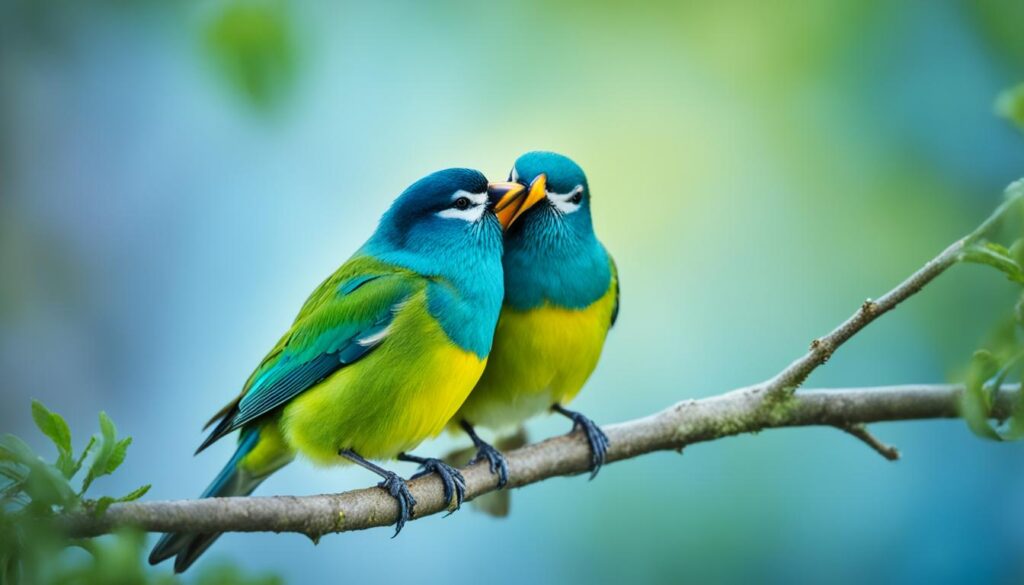Research shows that almost 60% of healthy parrots and cockatoos groom each other. This behavior, known as allopreening, shows their affection and trust. It’s a fascinating look into the social lives of birds, which can seem a lot like kissing to us humans.
Even though birds don’t kiss like we do, their actions have deep meaning in their groups. Watching how birds interact can teach us about the social bonds that are so important for their survival. It’s a chance to witness their support for each other up close.
Key Takeaways
- Allopreening, or birds grooming each other, is a common social behavior among various species, including parrots and cockatoos.
- Courtship feeding, where a bird feeds its mate, is observed in many bird species such as pigeons, doves, and eagles.
- Behaviors that resemble “kissing” play a crucial role in pair bonding, breeding, and strengthening social connections among birds.
- Understanding avian affection and courtship rituals can provide unique insights into the complex social lives of our feathered companions.
- Witnessing these behaviors can be a heartwarming and educational experience for bird enthusiasts and researchers alike.
The Meaning Behind the Bird “Kiss”
Birds show affection in fascinating ways. What looks like a “kiss” is part of their rich social life. Mainly, birds “kiss” through two key actions: allopreening and courtship feeding. These actions are crucial to understanding the deeper meaning of bird interactions.
Allopreening: A Grooming Ritual
Allopreening is more than grooming. It’s a bonding ritual for mates and flock members. Birds can’t reach certain parts of their bodies to groom. So, they help each other with this task. By grooming each other, they keep their feathers clean and strengthen their social ties. This shows how important their relationships are.
Courtship Feeding: A Mating Ritual
Courtship feeding often looks like a bird “kissing” another. Commonly, the male feeds the female as part of their mating ritual. This feeding act is a way for the male to prove he can provide for the female and their young. It’s a crucial step in their mating process. Through this feeding, the male shows his dedication and suitability for fatherhood.
| Behavior | Purpose | Example Species |
|---|---|---|
| Allopreening | Strengthening social bonds, maintaining plumage | Parrots, cockatoos, pigeons, doves |
| Courtship Feeding | Mating ritual, showcasing provider abilities | Pigeons, doves, some birds of prey |
While these behaviors might look like kisses, they’re vital in the bird world. They relate to survival, breeding, and building strong social groups. Understanding these “bird kisses” gives us a peek into the fascinating lives of birds.
“Birds engage in an act called ‘billing,’ involving beak-to-beak contact, which resembles human kissing, and serves different functions related to survival, reproduction, and social bonding.”
Birds That Engage in “Kissing” Behaviors
Some bird species show behaviors that are a lot like kissing. Parrots and cockatoos form strong bonds with their mates. They can often be seen preening or cleaning each other’s feathers, which may look like a kiss. Pigeons and doves also show what looks like kissing. Males feed their mates during courtship by passing food beak-to-beak. This helps the male show he can provide and makes him more attractive to his mate.
Parrots and Cockatoos: Preening Pals
Parrots and cockatoos are smart and sociable animals. They show love by preening each other, a behavior called allopreening. It’s not just about looking good; it’s also a way for them to bond. This includes touching beaks, which might seem like a kiss to us.
Pigeons and Doves: Courtship Feeders
Pigeons and doves follow a more traditional path in their relationships. During courtship, the males feed the females. This feeding involves regurgitating food to them, showing they can provide. It’s seen as a way to win over a partner by showing care and responsibility.
| Species | Behavior | Purpose |
|---|---|---|
| Parrots and Cockatoos | Allopreening | Strengthen pair bond, maintain plumage |
| Pigeons and Doves | Courtship Feeding | Demonstrate male’s ability to provide for potential mate |
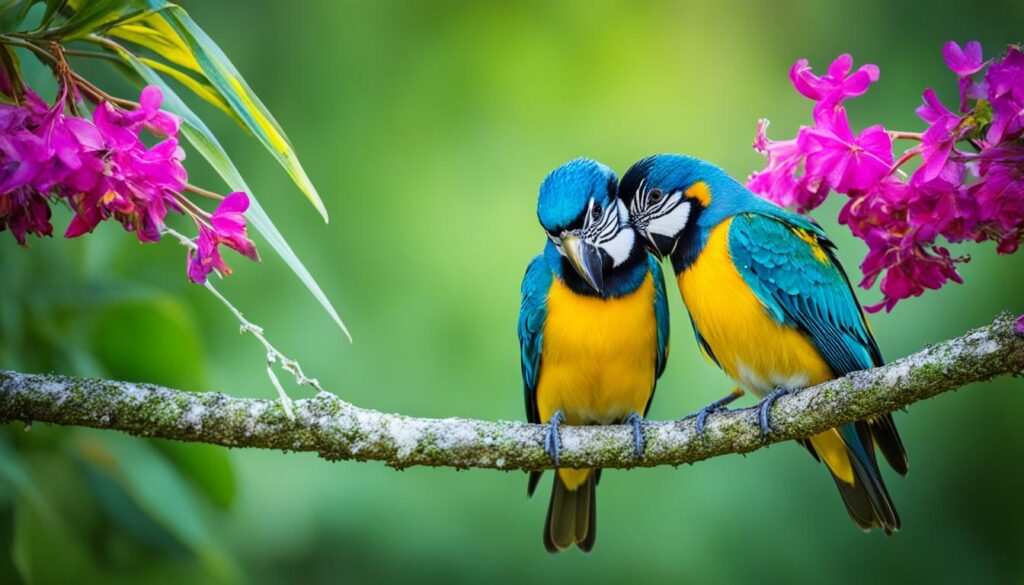
“Courtship feeding is a behavior in which one bird, usually the male, offers food to its mate. This behavior is thought to play a role in pair formation and maintenance.”
The Purpose of Courtship Feeding
Courtship feeding is key for many bird species in picking a mate and reproducing. The male bird giving food to the female shows he can provide for her and their young. This is crucial for the female when deciding to mate with him.
Courtship feeding has several roles. It shows the male’s hunting and gathering skills. Plus, it builds a strong bond between the birds. By sharing food, the male proves he’s fit and a good partner. This boosts his chances of mating.
This type of feeding also tells the female about the male’s health and overall quality. The food’s quality and amount show the male’s ability to care for the female and their youngsters. Females watch this to gauge if the male could be a good breeding partner.
“Courtship feeding is a common behavior among birds, where the male offers food to the female as a way to demonstrate his ability to provide and care for her and their future offspring.”
Courtship feeding carries on past just mating. It helps keep the pair close through the breeding season and even later on. By feeding her, the male makes their bond and commitment stronger. This partnership becomes more solid.
Focusing on courtship feeding is key to understanding bird mating and courtship. It is not just about attracting a mate. It’s a sign of the deep connections and changes in the bird world over time.
how do birds kiss
Birds might look like they’re kissing, but it’s not the same as human affection. They do these actions for different reasons. These actions help them survive and reproduce.
Allopreening and courtship feeding are the two main actions that seem like kissing. Allopreening is like grooming. Birds clean and groom each other’s feathers, usually around the head and neck. This strengthens their friendships and keeps their feathers healthy. Courtship feeding is part of a mating ritual. The male bird gives food to the female. This shows he is strong and a good mate.
| Behavior | Purpose |
|---|---|
| Allopreening | Strengthens social bonds and maintains feather health |
| Courtship Feeding | Part of the mating ritual, showcasing the male’s fitness |
These actions look like bird kisses but are not about love. They are important for how birds make friends, talk to each other, and survive together.
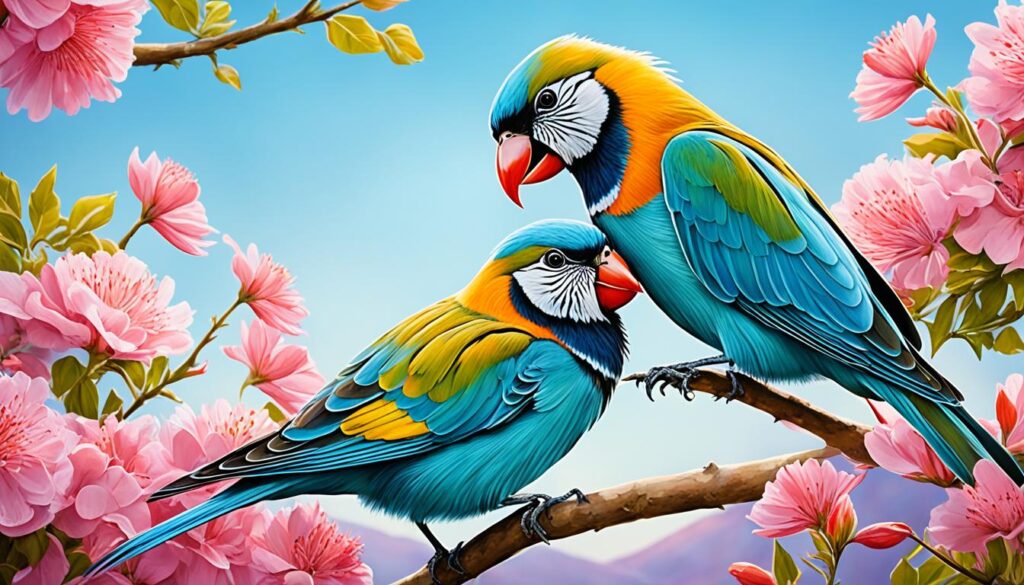
“Birds do not actually ‘kiss’ in the human sense of the word. Their behaviors that may appear like kissing are part of their social and reproductive rituals, not expressions of affection.”
We must not see bird actions as human. Understanding how birds truly act helps us truly see and love these amazing creatures.
Avian Affection: A Year-Round Affair
“Kissing” behaviors in birds, like allopreening, are most common in the breeding season. This season is when birds choose their mates and build lifelong bonds. Interestingly, various “kissing” actions continue throughout the year and are critical for many bird species.
Breeding Season Rituals
Birds have fascinating courtship behaviors during the breeding season. One of these, called courtship feeding, involves the male giving food to the female. This action shows his affection and proves he can provide. It helps make their bond stronger and is important for activities like nest building and raising chicks.
Another key behavior is allopreening, where birds groom each other’s feathers. This activity, seen all year, maintains the pair’s bond and keeps the birds’ feathers clean and healthy. This is crucial for staying warm and flying well.
Maintaining Social Bonds
Birds keep up with loving behaviors like allopreening after the breeding season. These actions are vital for keeping their flock or family together. They strengthen their connections, which is crucial for surviving tough times like during migration or when food is scarce.
“The puffins’ mating ritual involves kissing as a common sight to witness. The puffins go through bonding routines during their mating season which lasts between late March and early June annually.”
Birds truly value their relationships, even after choosing their mates. They engage in activities that show deep care for one another. These actions underline that birds are not just instinctual creatures; they have complex feelings and thoughts.
Parent-Chick Interactions: Not Quite Kissing
Beak-to-beak feeding between parent birds and chicks might look like kissing. But it’s not about love like with people. This feeding is critical for baby birds’ survival. They rely on their parents for food until they can find their own.
This feeding is key for chicks to grow and be healthy. The parent bird places food in the chick’s mouth. This way, the chick gets the nutrients it needs to thrive.
Parent birds feeding their chicks isn’t about showing love. It’s a vital step in family life for birds. It helps create a bond between them.
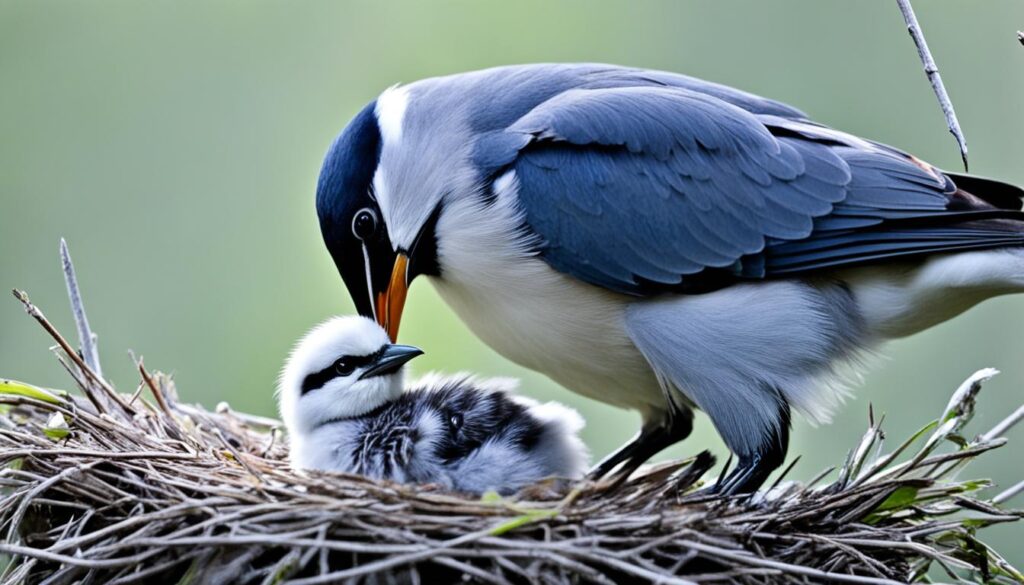
The chicks show they’re hungry by opening their mouths wide and crying out. This signals to their parents that they need to be fed. It’s a crucial dance for the chicks to survive.
Although it looks like a kiss, this feeding is all about function. It’s how bird parents care for their chicks, ensuring they grow up well.
The Science Behind Avian Saliva
People may worry about the dangers of human saliva to birds. But experts say it’s not that risky. A little saliva from a peck or “kiss” is usually fine for birds.
Gram-Negative Bacteria: Friend or Foe?
Many are afraid of gram-negative bacteria in human saliva. Some think it could harm birds. But, an avian vet says the tiny amount from a peck won’t make the bird sick.
Birds produce their own gram-negative bacteria. This bacteria actually helps keep birds healthy by aiding in digestion. It also stops bad pathogens from growing.
| Zoonotic Disease | Transmission Route | Potential Impact |
|---|---|---|
| Highly Pathogenic Avian Influenza (HPAI) H5N1 | Primarily through inhalation of contaminated fecal dust | Over 700 human infections reported to the World Health Organization (WHO) since November 2003, with a death rate of over 40% |
| Chlamydiosis (Chlamydophila psittaci) | Primarily through inhalation of contaminated fecal dust, with humans primarily exposed through infected saliva | Affects over 100 avian species |
| Salmonellosis (Salmonella) | Typically transmitted through the fecal-oral route | More than 2500 recognized serotypes, with fewer than 15 responsible for the majority of human infections, leading to symptoms such as diarrhea, vomiting, and low-grade fever |
| Colibacillosis (Escherichia coli) | Typically transmitted through the fecal-oral route | Can result in severe illness in humans, with symptoms including diarrhea and fever, and an incubation period ranging from 12 hours to 5 days |
| Encephalitis (Eastern Equine Encephalitis, St. Louis Encephalitis, or West Nile) | Transmitted to humans via mosquitoes | Primarily affect vulnerable populations, such as children under 15 years and adults over 50 years |
| Avian Tuberculosis (Mycobacterium avium) | Can cause local wound infections in humans | Results in chronic, debilitating diseases in bird species with tubercular nodes |
There is a small health risk from bird saliva to humans. But, it’s hardly something to worry about. Good hygiene and careful bird keeping are key to staying safe.
Understanding avian saliva’s science deepens our bond with birds. It shows how humans and birds connect in a special way. This knowledge makes our friendship with birds even more meaningful.
Debunking the “Toxic Saliva” Myth
Many people think human saliva can harm birds. But, after looking into it, this idea seems untrue.
Research shows birds don’t get sick from human saliva. For instance, the author’s grandmother fed baby birds using her mouth. This method was successful with very few birds dying within 48 hours, mainly due to their previous injuries.
To prove this further, the author talked to an avian vet. The vet said that birds were not at risk if people shared a quick kiss or peck with them. This means human saliva is not a big danger to bird avian health.
Some articles talk about toxic saliva, but they focus more on grabbing your clicks with scary titles. The parrot community doesn’t really trust these articles. They rely more on credible sources for info.
“The potential harm from human saliva to birds was deemed improbable based on the author’s findings from various sources, including a conversation with an avian veterinarian.”
It’s important to be careful when searching online. Some keywords can lead to false information. Always double-check what you read with trustworthy sites to understand the real risks.
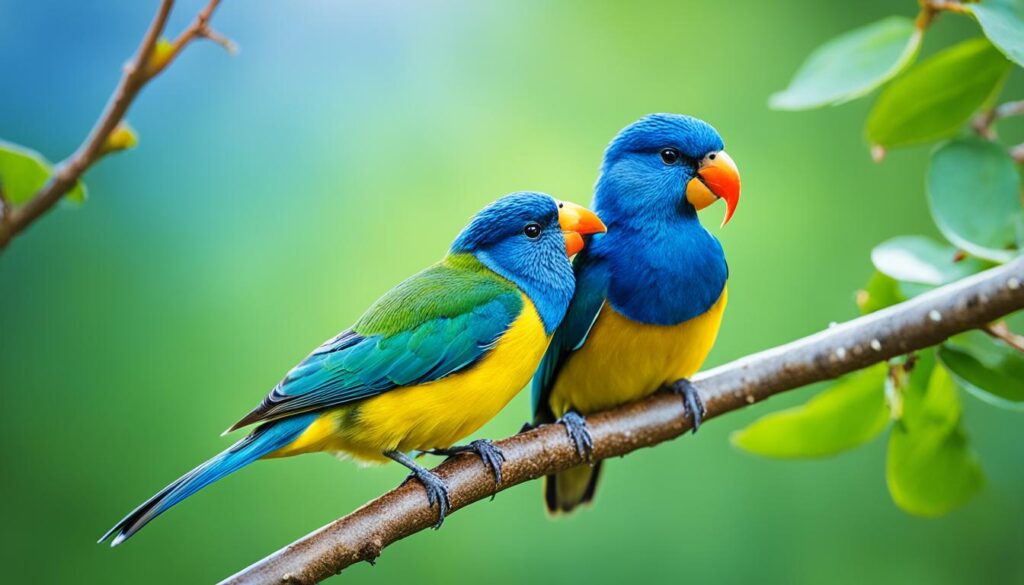
Responsible Bird Ownership: Kisses and Beyond
Understanding your bird’s affection is key. A light peck or sharing food can feel loving. But, it’s crucial to notice if your bird is happy with this.
Respecting Boundaries
Just like us, birds have different touch preferences and comfort levels. Some love soft touches, while others prefer less contact. Watch how your bird acts and adjust your actions. Don’t push them to like what they don’t.
By respecting their personal space, you build trust. Notice their signals like turning away or fluffing feathers. This tells you they might want some alone time. Giving them space when they need it makes your bond stronger. They’ll feel safe with you and show love in their own ways.
Alternative Ways to Show Affection
If your bird shies away from being touched, there are other ways to show you care. Treat them with their favorite snacks or play with them. Even just being near them and talking can make a big difference.
Using bird-safe toys or foraging puzzles is another excellent way to show love. These activities keep them happy and engaged. It strengthens the bond between you and your bird in a fun way.
Being a good bird owner means understanding and meeting your bird’s needs. By showing affection in different ways and making sure your bird is happy, you build a great connection. This relationship is satisfying for both you and your pet bird.
The Beauty of Avian Courtship Displays
The world of avian courtship is fascinating. It shows us how birds find their mates in complex yet beautiful ways. These behaviors are vital during the breeding season. They help in the continuance of bird species.
Most bird species, about 90%, showcase some kind of courtship display. These displays include various sounds, dances, and visuals. They aim to attract a mate and strengthen their bond.
At the peak of mating season, male birds perform these displays often. Some birds do up to 15 displays an hour. What’s more, about 75% of these rituals lead to the birth of new offspring.
The range of courtship behaviors among birds is astounding. From cranes dancing in the sky to peacocks showcasing their tails, birds’ adaptations are incredible. Such displays highlight their evolutionary success.
Courtship behaviors can differ due to the environment. Birds in areas with less food may have simpler rituals. They focus on finding a mate quickly rather than impressively.
But the charm of avian courtship goes beyond looks. It’s also about how birds identify each other and talk. Learning about these displays gives us a peek into birds’ lives. It shows the amazing diversity in nature.
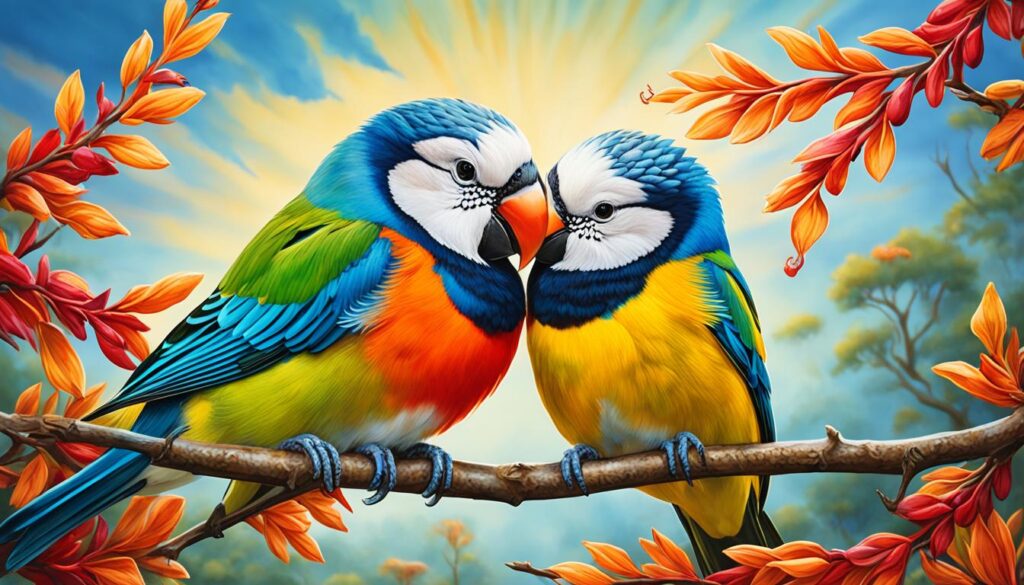
Exploring bird mating rituals and avian courtship behaviors reveals nature’s splendor. These behaviors are not just pretty; they are also key to bird survival. They teach us to value and protect the natural world.
Cultural Perceptions of Bird “Kissing”
Humans often see bird behaviors through our own cultural views and past experiences. This especially happens when we talk about “kissing” actions by birds. We might think they are expressing feelings like humans do. But, the real reason birds do this might not match our views.
Different bird species show “kissing” actions at various rates. For example, parrots and cockatoos often preen each other. When we watch, it looks like they’re kissing. Pigeons and doves, on the other hand, may seem to kiss during courtship feeding. This is when one bird puts its beak in the other’s mouth.
The way we see these bird gestures can change by where we live or our cultural background. For some, seeing birds “kiss” brings up feelings of love and friendship. But for others, it’s simply part of birds’ mating behavior. How people feel about bird behavior can affect how it’s shown in things like art and media.
| Region | Perception of Bird “Kissing” | Frequency in Media/Literature |
|---|---|---|
| North America | Anthropomorphized as a display of affection | Commonly portrayed in a positive, endearing manner |
| Europe | Viewed as a functional mating behavior | Less frequent portrayal of birds “kissing” in media |
| Asia | Interpreted as a symbolic gesture of fidelity and commitment | Frequent depiction in traditional art and literature |
By learning about cultural perceptions of bird behavior, we understand a lot. How we see bird “kissing” tells us more about our own ideas. Understanding bird mating and courtship behaviors helps us truly value the bird world.
“The way we anthropomorphize bird behaviors can reveal more about our own cultural lenses than the true meaning of the actions within the avian context.”
Avian Conservation and the Importance of Understanding Bird Behavior
The study of bird behavior is vital for their conservation. By learning about how birds interact and mate, we gain insights. These insights help us protect these amazing animals better.
Around 80% of bird species show affection through actions like kisses and sharing meals. These acts help birds bond and successfully raise young ones. It’s also key to keeping their populations healthy.
- Parrots and cockatoos are big on grooming each other. This isn’t just for looks. Preening keeps their feathers in top shape and strengthens their social ties.
- Pigeons and doves show love by feeding each other during courtship. This feeding is a sign of deep care and loyalty.
Learning about these bird behaviors is crucial for saving them. Avian conservation often involves watching how birds naturally act. This gives us important clues about their health and numbers.
“Understanding birds’ social lives and how they mate helps us protect them better. It’s essential for their future in a world full of dangers.”
Caring for pet birds and spreading the word about bird behavior helps, too. When we understand and meet the social needs of our feathered friends, we support bird mating rituals in the wild. This makes us part of the solution.
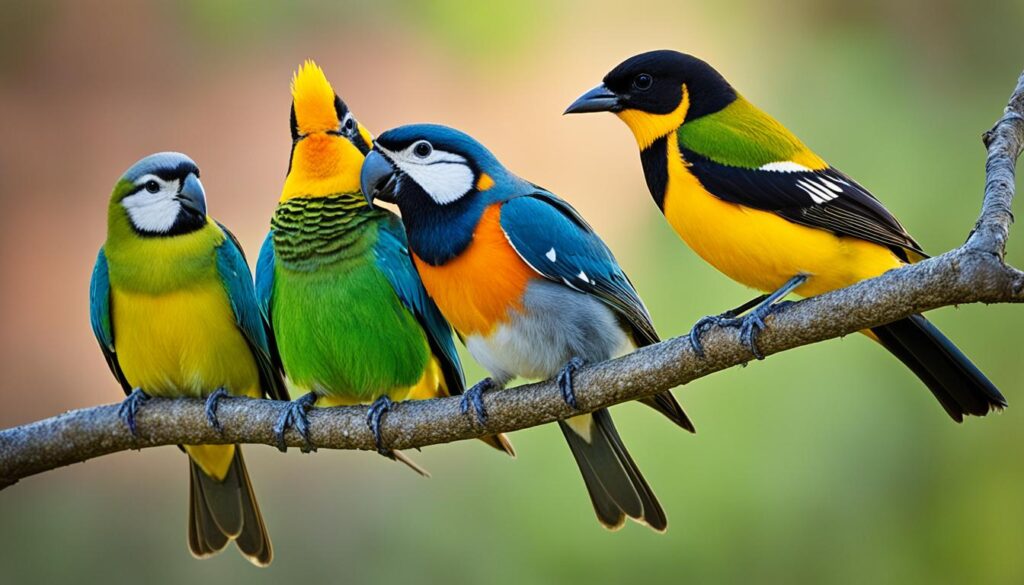
Deepening our knowledge of birds is key. It lets us create plans that really help them. This makes us value and save these unique animals. And it prepares us to face the challenges they’re up against.
Conclusion
This article has shown us different ways birds seem to “kiss,” like allopreening and courtship feeding. These may not show human-style love but are very important to birds. They help birds socially and in making babies. It’s key to respect these acts and learn their true meaning. This helps us value the complex lives of birds more. We should use this understanding to protect and care for them.
The article discussed how birds mate and show love, from the cloacal kiss to unique penises in waterfowl. These actions reveal the various ways birds have babies, unlike mammals. Learning about bird breeding season and family formation helps us see the importance of their behaviors. We can help in bird conservation by knowing about their relationships and behaviors.
It’s vital to let birds be and show love in ways that don’t harm them. Understanding how birds kiss and their behaviors is crucial. It promotes a better relationship between people and birds. This leads to a world where both humans and birds can thrive together.
FAQ
What do “bird kisses” actually mean?
In birds, acts that look like kissing are usually not about love. They might be birds grooming each other. Or, they could be males giving food to females as part of mating courtship.
What types of birds are known for “kissing” behaviors?
Parrots, cockatoos, pigeons, and doves often show these behaviors. They might preen each other or feed during courtship.
Why is courtship feeding important for birds?
Courtship feeding shows the male’s ability to provide. This is key for females picking a male to mate with. It’s crucial for their future young too.
Do birds experience “affection” like humans do?
Birds show social and mating behaviors that may look like kisses. Yet, these acts are not about affection the way humans understand it. Birds connect and court in their unique ways.
Is human saliva actually harmful to birds?
The amount of saliva from a human kiss won’t hurt a bird. But, we should still be careful. To show we care, it’s better to find other ways that are safe for them.
How can understanding bird behaviors help with avian conservation?
Learning about bird social and mating behaviors is important. It helps us protect bird populations. This knowledge is key in creating better conservation plans.
